#Kiriyama Family
Explore tagged Tumblr posts
Video
youtube
BARBiE: Kiriyama Family Edition
#Battle Royale#Batoru Rowaiaru#Mitsuru Numai#Kazuo Kiriyama#Hiroshi Kuronaga#Ryuhei Sasagawa#Sho Tsukioka#Kiriyama Family#Manga#Barbie Meme#horror manga#Meme
21 notes
·
View notes
Photo

KIriyama Inada brainrot continues. another late #BRWEEKEND2023 entry, Day 2, prompt ‘unlikely allies’.
Mizuho Inada the demon tamer, the warrior of light, saving Kiriyama Family with the ways and teachings of the wise man Ahura Mazda. Kazuo’s too confused to protest and just rolls with it. Sho is creased beyond help. Mitsuru is just happy his best broski has a bit weird but charismatic and POWERFUL girlfriend.
Once again the brave warrior Mizuho saves the day and runs with the lads into the sunset.
(also it’s basically the Girlfriend Shouting at Boyfriend meme because Mizuho would absolutely indulge in spewing her nonsense to anyone even slightly willing to listen. and since Kiriyama is ‘sure, why not’ about everything - let the LARP spread!)
12 notes
·
View notes
Text
My desperate plea to anyone else who likes the 'found family' trope in anime...
...please, PLEASE check out the manga/anime March Comes In Like A Lion, so that I'll have more friends to gush over this incredible masterpiece with!! I honestly don't know where to begin with this, but one thing I can confidently say is that Sangatsu no Raion contains one of the absolute best anime/manga depictions around what it's like to suffer from depression and complex PTSD, as well as, how one can find the means to heal by leaning on others.
The protagonist -- Rei Kiriyama, a 17 year old when the story begins, and a professional shōgi player (i.e. Japanese version of chess) -- is one of the most nuanced main characters I've ever seen portrayed in any medium. His learning how to navigate the pressures of his career while also grappling with his childhood trauma (bullying, the death of his parents/sister in childhood and subsequent adoption into a new family, etc.) is so incredibly moving, and it's my sincere hope that the amazing anime that Shaft studio produced might one day continue on with the manga source material.
Many fans agree that Rei is autistic/autistic-coded, and the portrayal of Rei's alexithymia (something I really don't think we see enough of in media) in particular is done so well and with such care. That element of intentionality truly does extend to so many of the characters in this show as well.
Just look at Rei's adorable face...don't turn your back on him, I beg!!
Oh and if nothing else, his story arc of finding 'home' within the Kawamoto family is guaranteed to give you all the warm fuzzies.


#sangatsu no lion#rei kiriyama#march comes in like a lion#found family#depression#kiriyama rei#autistic characters#alexithymia#autistic coded character
12 notes
·
View notes
Text
“its s2 ep 1 where he happily makes ramune with mr. hayashida & the shogi science club. he thinks how he can’t wait to show this to the kawamoto family. that brings so much joy to me! he is enjoying his time and looking forward to something!!!”
Way to make me cry, OP 😭 so perfectly said
*WARNING: SPOILERS AHEAD*
dont say i didnt tell you!
reasons why kiriyama rei admits and thinks to himself something like “i just wanna feel needed. is that so wrong?” This is based on his childhood. if you start to piece together his flashbacks, you start to understand him better.
it starts early on as a child. it happens at his parents’ & little sister’s funeral. we can see him alone looking over to the only family he has. i think he is looking to them for comfort but all they think about is themselves as the aunt and grandpa are fighting over who is taking over the family company. rei feels out of place as if he was not there at all. his presence is simply ignored. that’s why when mr. kouda shows up, he cries since he is the only other familiar person that reminds him of home. he cries since he is the only person there to acknowledge him.
when mr. kouda takes him in his home, rei tries to feel needed by making himself useful. he tries impress his adoptive father with shogi (e.g. solving those shogi problems with # of moves to checkmate) shogi is an important thing in that household so this works as he was really good at shogi more than his adoptive siblings & stepfather praised him for that
due to this, his step siblings, kyouko & ayumu, start to resent rei as he is the prized child in the home over the blood children. this causes a rift in their sibling relationships. there is a focus on kyouko who constantly berates rei & bullies him. making him feel as if he doesn’t belong. he then feels left out in the family even if stepfather tries to make him feel welcome.
rei tries to make his stepmother happy by helping her with chores. but this only makes his mother unhappy since when she gave them chores, the siblings would tell her “why not just let rei do it?” this makes rei feel incompetent because he tried to be helpful but it backlashed.
since rei feels really lonely, he looks to shogi, the only thing that can connect him to his father. in his mind, it is the only thing he is good at and makes him feel as if he is needed so he devotes much of his time to it.
in school, rei is often alone and no one seemed to like him. another classmate was supposed to sit beside him in the bus for a school trip but they insisted that they wanted to sit somewhere else instead. they were able to do so. rei becomes upset because that clearly shows how much no one wants to be with him.
in that same school trip, they had a lunch break and everyone broke out into groups. rei is left lonely again so he tries to find a spot to eat. he settles in the bushes and eats in an uncomfortable spot while solving more shogi problems.
again in another school trip, a bunch of boys are together. one asked “where’s kiriyama?” the other responds something along the lines of “who knows? who cares? it’s break time anyway we are free to do what we want”. rei overhears this and it feels like another hit as he is disregarded.
he simply accepted what happened to him at school as a part of life because that’s how its always been for him. he is used to this isolation. he even acknowledged how he spent his lunches alone for 11 years. and to avoid being the centre of attention due to being alone, he was pretending to be immersed in reading.
this is why he feels he has to excel at shogi. it’s the only thing that makes him feel he is needed, he is good, he can do something worth it. like he said in s2 ep 20 “this was the only thing i knew how to do” that’s why he tried so hard for hina, he tried to get a lot of wins to money to offer alternatives for hina like a private tutor or a switch of schools. because of this motivation, he even become rookie king!!! in the end, hina’s problem is resolved and rei feels like he did nothing for her & his work wasn’t worth it. but hina said “NO you’re wrong.” because he did help her by simply being there for her. rei couldn’t understand this because of how he grew up where results matter (specifically in shogi) & there was no one who was ever there for him as a child.
BUT
despite these unfortunate events, it’s what makes his story even better because as the story progresses we can see him bloom. we can see him interact with others, rely on them, realize that he is not alone & that there are others who need him and care about him.
i think its s2 ep 1 where he happily makes ramune with mr. hayashida & the shogi science club. he thinks how he can’t wait to show this to the kawamoto family. that brings so much joy to me! he is enjoying his time and looking forward to something!!!
with the kawamotos & the shogi science club, he is truly happy & he knows this that it makes him cry so hard. so upsetting tho because he even thinks how this happiness may not last as if he doesn’t deserve to be happy.
i adore seeing him as he starts to open up, smile more & become happier. and that makes me cry so hard because it’s truly what this considerate lil bean deserves. i loved watching such a phenomenal show and tagging along rei kiriyama’s story.
it is so bittersweet since at first, his life was always void of colour.

now, it is full of colour due to the people in his life.
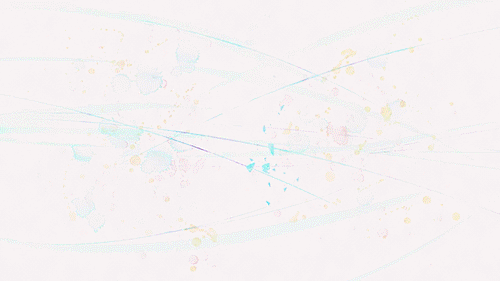

#rei kiriyama I will always root for you#a god tier post for a god tier character#rei kiriyama#march comes in like a lion#sangatsu no lion#found family
53 notes
·
View notes
Text
Don't See Yourself As a Cuckoo
I started reading Chica Umino's March Comes In Like a Lion after years of hearing about its great outlook on characters dealing with a variety of emotional issues. In particular, its main character, Rei Kiriyama and his struggles to come to terms with his past involving a surrogate parental figure who raised him after his family died, but ignored their own kids for the sake of Rei's future.
I see this first hand near the end of the 1st volume when Rei reminisces about the past and how he got into shogi.
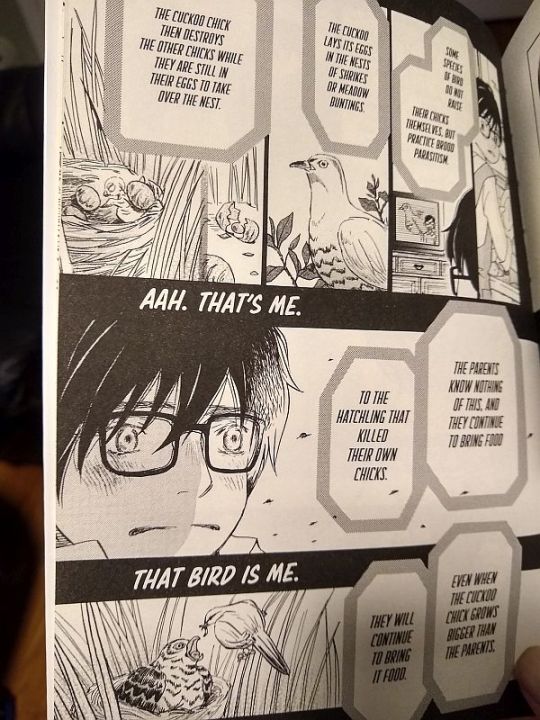
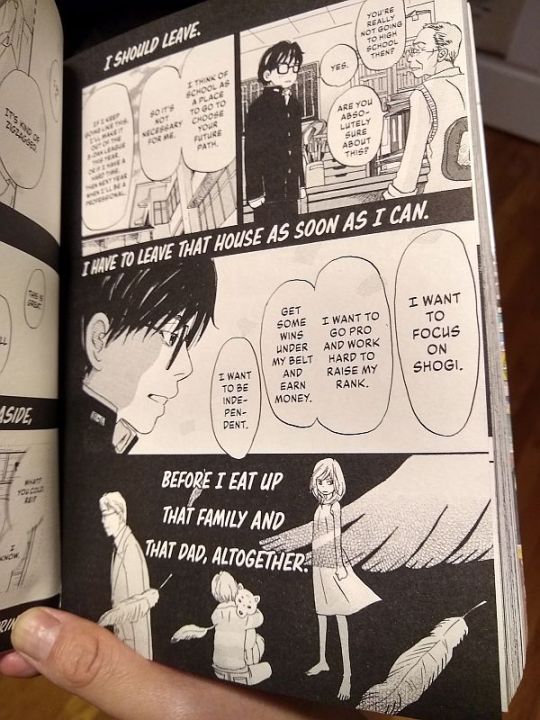


It's scary that I felt the same as Rei about 13 years ago. I remember one time where I felt like I was dragging my family down a hell hole when we moved into a new living situation. I was dealing with so much uncertainty and didn't know how to handle it. I think at the time, we had limited resources. I felt that I was selfish because I wanted to move to a better place badly over everyone else's preferences, but my sister reminded me that I wasn't the only one who wanted out. She even said my thinking was warped. I think I was just so afraid of hurting my family and felt they had to do so much for my depression. I wanted them to stop helping me. I felt like a cuckoo despite not actually being a cuckoo.
When I look back at that time now, I realized that I was facing a new situation that I was overreacting to. It's fine to react in ways that make you fearful, but there's a point where it affects your relationships in not-so-healthy ways. You have to be realistic and trust in the people around you despite what your inner critic says.
Rei's quote about being a bird and free of emotional pain reminded me of my experiences with birds. I used to have a pet African finch and felt that he had it much easier than me. He got to eat, sing, fly around, sleep, poop, etc. And then I remember my finch lived in a cage and was taken care of by creatures (i.e. human beings) that he can't exactly communicate with. There's no freedom for him here. And even if my finch was free and roaming, he would have to deal with how vicious wild birds are due to being domesticated. My finch died in 2019 after 11 years of raising him and while I do think he lived a long life for his kind, I have to be careful in saying he lived a good life.
After my finch died, I later discovered an avian center that housed birds of all kinds that were on display while walking on a lunch break from work. There were a variety of them living in a special housing display for everyone to see. All of them were either injured, old, and/or couldn't be raised by regular folks. I had a lot of joy looking at those birds and would walk by to see them almost all the time. Some of them did die over time, but the birds reminded me how important it is to recognize that we deserve people to care for us when life deals us a terrible hand. I still stop by the avian center bird display because all the birds there are precious to me.
I sometimes wished I was a bird because it sucks being sad a good amount. It sucks to cry when you least expect it. And then I think about what that actually will entail. I don't want to anthropomorphize animals because it's hard to compare.
The grand truth is that everyone and everything (humans/animals/plants) goes through pain in some fashion. We decay and wither from time to time. That's how life works. Obviously, some pain isn't worth it. But I feel that we have to appreciate to a certain degree how we learn who we really are through our rough experiences. They make us value what's important in our lives. Despite whatever gaslighting we may get, we can get through the pain and/or live with it in healthy ways.
I will say that one thing I notice about birds is that they're usually together a lot. During the 1st year of COVID, I saw a family of mourning doves living in the back of my place for a short time. It was one of the cutest things I ever saw. The parents would fly away to look for food, while the kids parked themselves at their temporary home. I don't know how they're doing now, but I like to think that they're doing okay out there. Whenever I see families of mourning doves, I think of that one family.
Maybe a part of me still wants to be a bird - soaring into the air and being out in nature, free of modern life constraints. The real cuckoo isn't me; it's those who want us to ignore the interdependence of all things that truly makes human beings feel that they matter.
If you ever feel like you're a cuckoo, it's not your fault. You're a person who deserves the unconditional foundation to live a life full of love to process the pain you unfortunately had to deal with.
Much like what the manga seems to entail, springtime is a time to renew yourself with others around, whether human or animal, after the harshness of winter.
#March Comes In Like a Lion#manga#anime#Rei Kiriyama#depression#solitude#loneliness#birds#psychology of birds
15 notes
·
View notes
Note
for the oc ask!
What was their childhood “thing”? (e.g. Pokémon, dinosaurs, princesses...)
What does (would lol) their Tumblr look like?
Name a character from a different fandom they'd get along with.
13. What was their childhood “thing”?
Actually, Rie spend most of her time in books as a kid. Dinosaur books. Fairy tales. Texts by old dead guys (Freud and Descartes kind of thing). Anything with words. I guess that's not a thing in the way I meant it, though.
So, I'll say flowers. Rie had a long phase of memorising the scientific names of each one and its common meaning. She also liked making bouquets for her family and friends. If she had friends. I still haven't written her backstory.
17. What does their Tumblr look like?
answered here :)
I'll add though, lots of fanart of characters Rie likes. As for her page, it's probably the same colours as mine but with no information. she'd get blocked as a bot nonstop... But that's social media when you're part of the agency ‘L’.
22. Name a character from a different fandom they'd get along with.
This took a while to think up, but I think Kaori Miyazono from Your Lie in April. It's been a while since I watched it, but I still remember the way she and the story made me feel. They're both cheerful and positive despite the sadness in life, and the sadness they themselves have. I can't really get into explaining this more without rewatching it, but you guys should watch Your Lie if you haven't.
Also, Rei Kiriyama from March Comes in Like a Lion. The shows remind me of one another, though the characters are different. Rei is more like Kōsei than Kaori. Rie and Rei would probably play shogi together in thoughtful silence. Rie's not very good, though...
They're both a bit younger than Rie, but I found it difficult to think of other fandom characters in their twenties she'd get along with.
11 notes
·
View notes
Text
So recently I finished reading Battle Royale which I was struggling to finish for quite a while. Not because it was bad (though it did have it's issues) but because I always pick it up at seemingly the worst time. The first time was the end of my Bachelors, this time it was during my Masters. But I did finish it, this time and that was partly because I was able to keep track by keeping a notebook, which I will show pictures from below.
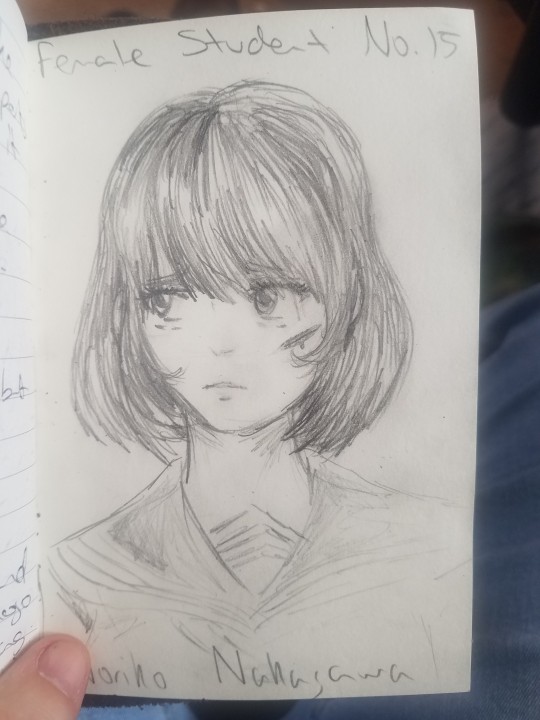
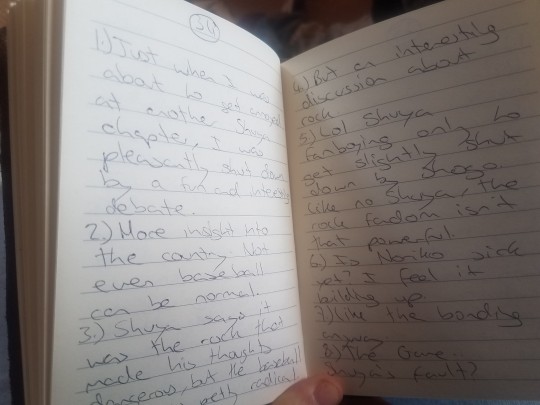
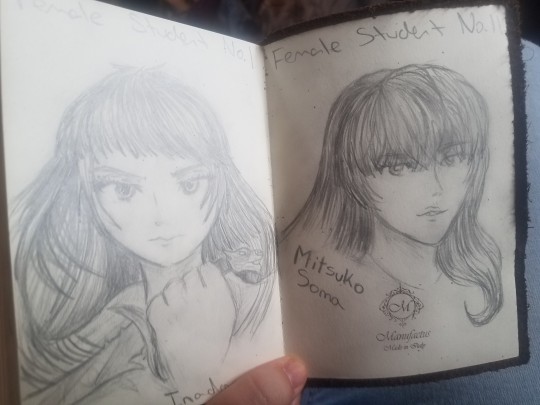
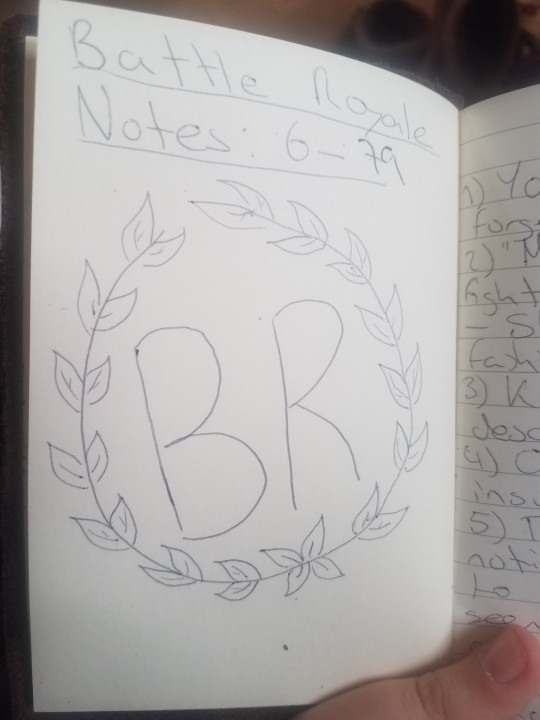
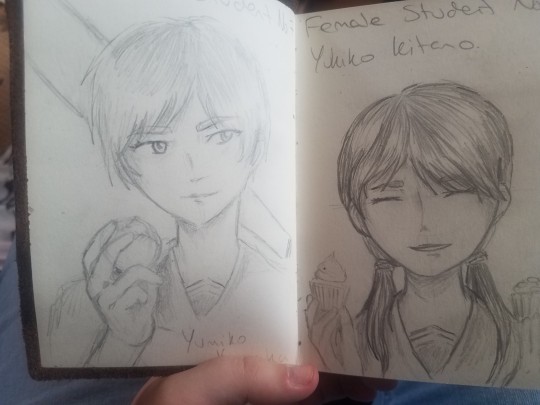
(I don't know why tumblr decides to show them upside down but fuck me I guess. Also my writing may or may not be readable, i tend to have child doctor hand writing)
I did some drawings of the characters on the inside, as you can see. I did tend to favor the female characters, not gonna lie so that's why I've been drawing them. I just found less of them insufferable (also drawing girls is easier). Their appearance wasn't based on the books or the manga, though they did have a slight influnlence. I mostly got inspo from @dullahanart who is really talented.
Now I didn't hate all of the guys. I LOVED the Kiriyama family and their chapter/s were some of my favourite parts.
I also liked Shogo and I wish he was explored more outside of having to talk to Shuya.
Speaking of him. That is my main problem with the story. I couldn't stand half the people who were meant to be the main characters. It's a shame because Noriko and Shuuya have such potential (especially the former).
And I understand the point of Shinji, but only because I watched a video on the series that explained him way better than the book. I couldn't stand reading him, and I dreaded any chapter that involved him because I soon realised he was the culprit of why I couldn't finish the book before. Talk about an actual Gary Stew, and I'm not even using that as a buzz word here. I've never read such an unbearably perfect character.
I think instead of giving a main cast and telling them "these are the characters you should like", the story could have benefited from having no definitive main character or "winner". You can tell who is going to survive pretty early on, and honestly it really downplayed the steaks. I would have prefered if each character got equal attention so that nobody could tell who would come out of it. That way, one could really get more invested in the side characters, who are all the highlight of the book.
But I don't know, that's just my opinion. I honestly think I like the movie more, but I can at least say I prefer the book to the manga.
#battle royale#books#i don't know any other tags but the characters names but they're all too long and my phone is running out of battery so
9 notes
·
View notes
Note
I just want to say... seeing Gentaro act like a smart cookie is so surreal lol! (pinanuod ko yung As the gods will na movie niya)
He was also kinda smart in Laughing Under the Clouds... Like if he weren't stuck at his home tending to his familial duties he could've been a successful career soldier, that's the level he was at.
But what really threw me for a loop was the unadulterated UST between him and this other charac. Like... they were basically raising two kids together like husband and wife (the other character was a "freeloader", but he did all the chores lol). And there were moments when they gave each other these looks...
The kicker? He was played by Renn Kiriyama. Hidari Shoutaro!! Having UST with his kouhai! My brain couldn't compute!
It took everything in me not to shriek (I watching it in my hotel room while I was in Japan a few years back).
Such is the wonder of witnessing toku stars in non-toku media
4 notes
·
View notes
Text
Top 10 Anime Like Oshi no Ko (My Star) to Watch in 2023
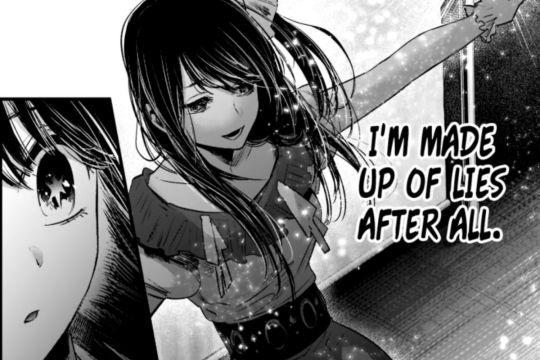
The world of anime continues to captivate fans around the globe with its diverse range of storytelling and captivating characters. "Oshi no Ko," a popular anime series that aired in recent years, has garnered significant attention for its unique premise and compelling narrative. If you enjoyed "Oshi no Ko" and are looking for similar anime experiences, this article presents a hand-picked selection of the top 10 anime to watch in 2023 that share similar themes and qualities. From intense character-driven dramas to heartwarming tales of growth and friendship, this list covers a variety of anime like Oshi no Ko or better known as My Star.
Top 10 anime like Oshi no Ko (My Star)
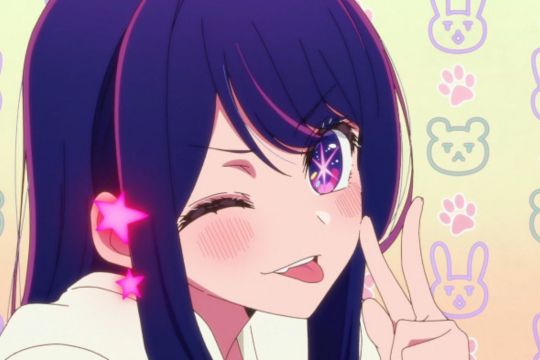
Shirobako https://www.youtube.com/watch?v=-DUqUGFYx48&ab_channel=ShoutStudios "Shirobako" delves into the behind-the-scenes world of anime production, exploring the trials and tribulations a group of friends faces as they strive to make their dreams of creating anime a reality. With its realistic portrayal of the industry and endearing characters, this anime offers a cute glimpse into the world of animation. Bakuman https://www.youtube.com/watch?v=CG0Z23fZRbw&ab_channel=vizmedia "Bakuman" follows the journey of two aspiring manga artists as they navigate the competitive publishing world. With its blend of drama, romance, and comedy, this series showcases the challenges faced by artists and the determination required to succeed in their chosen fields. Sakura Quest https://www.youtube.com/watch?v=hVq-r9HimDI&ab_channel=KloposAnimus In "Sakura Quest," a young woman named Yoshino finds herself unexpectedly working as a tourism ambassador in a rural town. This slice-of-life anime explores personal growth, community, and the importance of finding purpose in unexpected places. Sakamichi no Apollon (Kids on the Slope) https://www.youtube.com/watch?v=7plEDcWy0Oc&ab_channel=HanabeeEntertainment Set in the 1960s, "Sakamichi no Apollon" follows the story of Kaoru, a reserved student, and Sentarou, a talented drummer. Their shared love for jazz music forms a bond that transcends societal barriers, and the anime beautifully portrays their friendship against a backdrop of youthful passion. Chihayafuru https://www.youtube.com/watch?v=Y8U-E8hldHk&ab_channel=Sentai "Chihayafuru" is a sports anime centered around the traditional Japanese card game karuta. The series follows Chihaya as she aspires to become the Queen of Karuta while exploring themes of friendship, determination, and personal growth. Hibike! Euphonium" (Sound! Euphonium) https://www.youtube.com/watch?v=KxowSlinlb0&ab_channel=AlltheAnime This music-centric anime focuses on the Kitauji High School concert band striving for excellence and overcoming internal conflicts. With meticulous attention to detail, "Hibike! Euphonium" provides a heartfelt and realistic portrayal of the dedication and passion required to pursue musical excellence. Sora yori mo Tooi Basho (A Place Further than the Universe) https://www.youtube.com/watch?v=tAYL5VNAJq0&ab_channel=AnimaxAsia Four high school girls embark on a journey to Antarctica in "Sora yori mo Tooi Basho." This coming-of-age tale explores friendship, self-discovery, and the pursuit of dreams. With its breathtaking visuals and emotional storytelling, this anime resonates deeply with its audience. 3-gatsu no Lion (March Comes in Like a Lion) https://www.youtube.com/watch?v=ZL5nnx4vd7k&ab_channel=AniplexUSA "3-gatsu no Lion" delves into the life of Rei Kiriyama, a young professional shogi player struggling with loneliness and depression. The anime showcases Rei's journey as he confronts his demons, finds solace in unexpected friendships, and discovers the true meaning of family. Hanasaku Iroha https://www.youtube.com/watch?v=XYvnsxzbepU&ab_channel=NISAmerica "Hanasaku Iroha" follows Ohana Matsumae as she starts working at her estranged grandmother's traditional Japanese inn. This slice-of-life anime delves into Ohana's personal growth as she learns about responsibility, relationships, and embracing change. Barakamon https://www.youtube.com/watch?v=1gmN_3kr4wo&ab_channel=AlltheAnime "Barakamon" revolves around the life of a calligrapher named Seishuu Handa, who is exiled to a remote island after an artistic mishap. Through his interactions with the eccentric locals, Seishuu learns valuable life lessons and again discovers his artistic voice.
Conclusion
If you enjoyed the charm, depth, and unique storytelling of "Oshi no Ko," this list of top 10 anime like Oshi no Ko provides a diverse range of options. Whether you are interested in anime production, character-driven dramas, or heartwarming tales of growth and friendship, these anime series will surely capture your attention and leave a lasting impact. Immerse yourself in these anime titles' captivating narratives and vibrant characters, and let them transport you to new and exciting worlds in 2023. Read the full article
2 notes
·
View notes
Text
I do, I really do feel bad, for the fans who liked Kiriyama and Hina-chan best as platonic siblings, because the author REALLY should not have pushed the platonic family angle if she planned to make them romantic after all.....
..............but selfishly speaking the whole storyline is so fucking funny.
0 notes
Text
Anitaku – Sweet Slice of Life Anime [Feel a Lot at Home]
Introduction:
In an age of thrilling and hyperkinetic anime, there is something to be said about slice-of-life serving as a soft reprieve from the daily pulse. Slap-bang in the middle of this wildly frenetic genre, however, is a diverse world with its sights set on more conventional experiences and softer relationships: brimming at every point with emotional peccadillos that make it still one of the most beloved areas for many anime fans. With this piece, we look at some of the series that embody these little moments slice-of-life with all the warmth and depth it needs to be unforgettable.

1. What is Slice of Life Anime?
Defining the Genre
Slice of life anime showcases the daily lives of characters and is more realistic in a sense that such series tend to focus on minute, relatable experiences rather than grand plots. This, in turn, showcases its major themes regarding friendship and self-discovery alongside love and family all within the span of a cozy slice-of-life outing. Clannad (2007) and March Comes in Like a Lion (2016), for example, highlight the mastery [sic] with which more subtle territory of emotions can be struck by a aldente composite-character.
A Window into Real Life
While the fantasy or action genre is just some fiction, slice of life actually captures current experiences and aspects from real-life that can make it even easier for viewers to feel they are watching something like their own lives. These anime try to tell grounded stories and make the audience stop, breathe, confess life's sundry little joys such as eating your favorite dish or walking around looking at a sunset or bonding with people.
2. Slice of Life Made Me Emotional
Characters that feel like people and relationships characters have with one another.
The heroes in slice of life anime tend towards being normal humans who are simply trying to live their best lives day by day, making friends or finding meaning where they can: whether that be the drama high school setting, wanting your big break as a band singer songwriter combination. My Youth Romantic Comedy Is Wrong, As I Expected (2013) and the recently popular Horimiya (2021), for example, delve deep into what it means to forge a relationship with another human being shamelessly exploring through awkwardness but also tenderness there is in two people simply There.
Sweet Moments of Affection区 Classification'][]];UIBarButtonItem[['Title.pm':'Bittersweet.
Shoujo Crafts | I live my life just laughing?Slice of Life has its own slice, dear to me at least in anime, succeeding on little victories almost entirely hidden from…shinmeiartist.wordpress.com Shows like Anohana: The Flower We Saw That Day (2011) and Your Lie in April (2014) are prime examples of a genre that can illicit powerful emotions out of simple yet meaningful stories about friendship, grief, and recovery. The primary reason behind the popularity of these anime is that they make people feel peace since we are all reminded how moments like this can be brief and really beautiful.
3. Heartwarming Slice of Life Classic Anime
TWO SEASONS: clannad (2007-08) / CLANNAD AFTER STORY
In the world of heartwarming, heartfelt storytelling, this is a luxury that everything must see. Clannad – This is a slice of life and follows the story from Tomoya Okazaki, troubled high school student to help Nagisa Furukawa shy girl with their dream excursion charm club your new college revive. Season one is good with cute moments that happen everyday, but the After Story actually makes me cry and shows more about reality like how family works (I love you Nagisa!!), or overall life of adult themes.
March Comes in Like a Lion 2016
This gentle breath of an anime traverses the life and mental health struggles — experiences we typically consider quietly to ourselves but never in a million years shout out loud to strangers on social media, or even friends without immense trust—of Rei Kiriyama, a young pro shogi player. It is a profoundly touching experience to witness Rei finally coming into his own as person but the series also balances these melancholic images with glimpses of what it's like find community that genuinely has your back. The realistic depiction of struggles and progress is what makes this series so relevant.
Barakamon (2014)
Barakamon tells the tale of Seishuu Handa, a young calligrapher exiled to an island backwater. They farmers there, quirky villagers and learns simplicity friendship self expression. The comedy, sweet bonding scenes and valuable lessons are a breath of fresh air in showing that we all need to take is slow down sometimes and appreciate the little things.
A Silent Voice (2016)
While technically an anime film, A Silent Voice is like a slice of life with its exploration on relationships and emotional learning. The film revolves around Shoya Ishida as he tries to make amends with and seek forgiveness from a deaf girl named Shoko Nishimiya who was tormented by him back in elementary school. As a narrative on redemption, it speaks volumes to the effects our actions have on others and creates stories about guilt, forgiveness and understanding in stirring fashion.
4. Slice of Life Anime — An Unmatched Appeal
Tranquil Surroundings this is the visible beauty
Slice of life anime tends to gloriously offer serene locations that compliment its quiet and more intimate feels. Whether you look at the great wide yokai countryside in Non Non Biyori (2013) or stroll through the expansive city streets of Fruits Basket. The vibrant visuals, at the same time relaxing complements each scene to enrich an overwhelming emotional ride.
Cute Animation and Art Style
Slice of life anime usually does a great job with subtle facial gestures and intricate backgrounds when it comes to emoting through visuals. Shows like Your Lie in April (2014) and March Comes in Like a Lion use subdued animation techniques and metaphorical visuals to express the feelings of their leads. These narratives are accompanied by beautiful, minimalistic yet expressive art which adds to the overall aesthetic of quiet beauty these stories attempt to convey.
5. The Attractions of Slice-of-Life Anime
Break from Action Entertainment
In a world where media is fast-paced, slice of life anime just feels that kontiu. It gives people the time to take a break and appreciate little abundance of life that is often left unappreciated. Between the relationships, growth and quiet moments in slice-of-life there is a counterweight to high-stakes drama of other kinds you tend to see within anime.
In terms of relatability and emotional depth
Slice of life anime, in general are very personal stuffs and that is why it works so well with people. It deals with existential conflicts and issues (such as the coming-of-age theme in Hyouka, or coping up pressures of work vis-a-vis aspiration rue Shirobako) that touch everyone. It offers the lesson that even little things can be important.
6. The Role of Slice of Life Anime in 2024
An Evolving Genre
In 2024 slice of life anime is expanding its horizons it has blended with other kinds if genres like romance, comedy and drama to create stories that are quite warm & consoling. Blue Period (2021) and Komi Can't Communicate (2021), both are more recent titles that incorporate also Humble Slice of Life stories without discarding the elements Type Moon has long since mastered before but with a fresher take on modern themes like self-expression and social anxiety.
Release on a Streaming Platform and Worldwide appeal.
The advent of online, streamed services such as Netflix or Crunchyroll allowed the slice-of-life genre to reach a wider global audience than ever before. This is a moral of the story, quiet way winning films like Laid-Back Camp (2018) and Aggretsuko apssword: anything to contain real success with international viewers who not merely comment on ordinary life history passes kidding xane but find these stories relevant despite nuance in their shared culture.
Conclusion:
Everyone loves a good slice of life anime — they offer fans an emotional respite through the tenderness and heartwarming nature of everyday general living. From timeless works such as Clannad to new masterpieces like March Comes in Like a Lion, the genre still manages grab hold of fans with its heart-wrenching themes and stories but which of these anime is worth your time? And in that regard, slice of life anime is undoubtedly set to warm our hearts for 2024 and give us precious slices out of the slower aspects of existence.
Touching on all the fresh aspects of slice-of-life anime in terms of what lies at its soul, and examining with a combination of vintage components that everyone toasts together is just one post that might appeal to fans oldish hardcoretee awesome guys.
0 notes
Text
ok so I think Yabuike would be twilight upon entering Ponyville. and the worker dudes trying to plant trees in the forest are like apple jack and the apple family. then the botanist sisters are celestia and luna. ummm and Kiriyama is sweetie belle and the old lady hes taking care of is rarity.
1 note
·
View note
Text
Die Welt des Anime ist groß und vielfältig, mit Genres, die sich an ein breites Publikum richten. Das Seinen-Genre sticht dabei hervor, denn es spricht eine erwachsenere Zielgruppe an und bietet komplexe Erzählungen, tiefgründige thematische Auseinandersetzungen und Abweichungen von den konventionellen Tropen, die man häufiger bei Serien findet, die sich an eine jüngere Zuschauerschaft richten. Dieser Artikel taucht ein in einige der meistgepriesenen Seinen-Anime, die sich jeweils durch ihre einzigartige Erzählweise, Themen und Charakterentwicklung auszeichnen. 1. Pluto Pluto verdient besondere Erwähnung im Seinen-Genre. Inspiriert von Naoki Urasawas Manga, ist diese Serie eine Hommage an Osamu Tezukas Astro Boy. Sie spielt in einer Welt, in der Menschen und Roboter koexistieren und dreht sich um einen Roboter-Detektiv, Gesicht, der die Geheimnisse um eine Serie von Toden aufklärt. Diese auf Netflix verfügbare Serie zeichnet sich durch ihre komplexe Handlung und thematische Tiefe aus, die die Komplexität einer solchen Welt beleuchtet. 2. Psycho-Pass Psycho-Pass, ein Cyberpunk-Thriller, hat sich als Klassiker des Animes etabliert. Die Geschichte spielt in einem dystopischen Japan, in dem Individuen anhand ihres „Psycho-Pass“ bewertet und kategorisiert werden. Die Serie konzentriert sich auf die Reise der Inspektorin Akane Tsunemori und ihre Verfolgung eines beeindruckenden Widersachers. Die Serie, die auf Crunchyroll und Amazon Prime Video verfügbar ist, wird für ihre Auseinandersetzung mit gesellschaftlichem Wert und Freiheit innerhalb ihrer Erzählung gelobt. 3. Code Geass Code Geass hebt sich mit seiner alternativen Geschichtsschreibung und einer Mischung aus übernatürlichen und Mecha-Elementen hervor. Es folgt dem verbannten Prinzen Lelouch vi Britannia, der mit der Macht des Geass ausgestattet ist und einen Pfad der Rache und politischen Intrige beschreitet. Die Serie, die auf Amazon Prime Video und Crunchyroll verfügbar ist, fesselt die Zuschauer mit ihrer hochbrisanten Erzählung und moralischen Komplexität. 4. Kaguya-Sama: Love Is War Vom traditionellen Seinen-Element abweichend, verbindet Kaguya-Sama: Love Is War romantische Komödie mit Slice-of-Life-Genres. Erzählt wird die Geschichte zweier Oberschüler, die in einem strategischen Kampf darum ringen, ihre Liebe zu gestehen. Diese Serie, verfügbar auf Funimation und Crunchyroll, porträtiert charmant die Komplexität jugendlicher Romantik und Beziehungen. 5. March Comes in Like a Lion Diese Serie bietet ein seelenvolles Erlebnis und begleitet Rei Kiriyama, ein Shogi-Wunderkind, das mit persönlichem Verlust kämpft. Sie fängt auf wunderschöne Weise seine emotionale Reise zum Verständnis von Familie und Liebe ein. Der Animationsstil und der außergewöhnliche Soundtrack tragen zur eindringlichen Erzählung bei. 6. Hellsing Ultimate Hellsing Ultimate ist eine fesselnde Serie voller übernatürlicher Schlachten. Sie folgt dem Vampir Alucard und seinem Dienst für die Hellsing Foundation und ist bekannt für ihre intensive Action und komplexen Charakterdynamiken. Sie beschäftigt sich mit Themen der Moral und Existenz über die blutigen Actionsequenzen hinaus. 7. Parasyte: The Maxim Themen wie Koexistenz und Identität erforschend, erzählt Parasyte: The Maxim die Geschichte von Shinichi Izumi, einem Oberschüler, der zum Wirt eines außerirdischen Parasiten wird. Die Serie vertieft sich über ihr sich entwickelndes Narrativ in Überleben, Menschlichkeit und moralische Fragen. 8. Mushi-Shi Mushi-Shi sticht mit seinen philosophischen und mystischen Themen heraus. Es folgt Ginko, einem 'Mushi-Shi', der Lebensformen namens 'Mushi' untersucht. Die Serie wird für ihr besinnliches Erzählen gefeiert, das Mystery, Fantasy und Slice-of-Life-Elemente vermischt. 9. 5 Centimeters per Second Dieser romantische Seinen-Anime porträtiert eine realistische Liebes- und Beziehungsgeschichte. Erzählt wird von Takaki Toono und Akari Shinohara, deren Liebe durch Distanz und Zeit auf die Probe gestellt wird, und reflektiert dabei die emotionale Reife und Realitäten von Beziehungen.
10. Erased Erased konzentriert sich auf einen Mann mit der Fähigkeit, in der Zeit zurückzureisen, um Katastrophen zu verhindern. Diese Seinen-Serie brilliert durch den Einsatz von Suspense und Mystery und fesselt die Zuschauer in einem Wettlauf gegen die Zeit, um die Vergangenheit zu ändern und geliebte Menschen zu retten.
0 notes
Text
March Comes In Like A Lion 2nd Season
Now in his second year of high school, Rei Kiriyama continues pushing through his struggles in the professional shogi world as well as his personal life. Surrounded by vibrant personalities at the shogi hall, the school club, and in the local community, his solitary shell slowly begins to crack. Among them are the three Kawamoto sisters—Akari, Hinata, and Momo—who forge an affectionate and familial bond with Rei. Through these ties, he realizes that everyone is burdened by their own emotional hardships and begins learning how to rely on others while supporting them in return. Nonetheless, the life of a professional is not easy.
#animixplay #animixplayfree #animixplayonline
See more: https://animixplay.is/movies/detail/march-comes-in-like-a-lion-2nd-season

0 notes
Photo
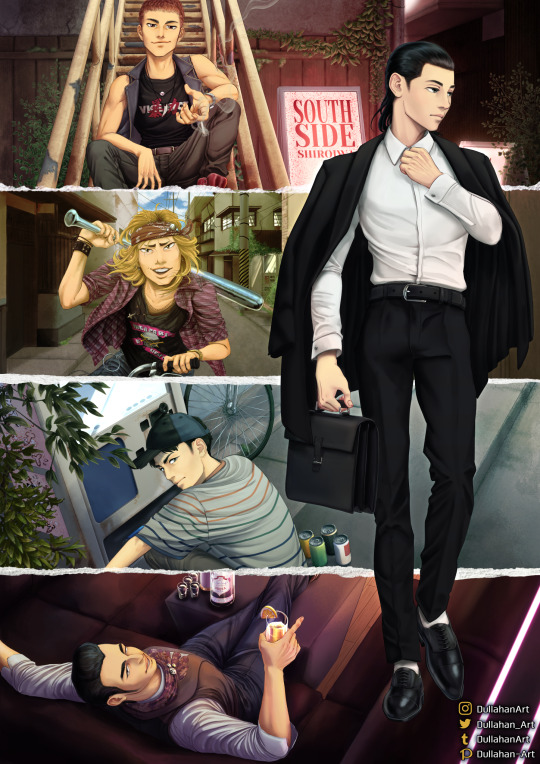
Battle Royale Week
Day #01: [Kiriyama] Family
#battle royale#batoru rowaiaru#kazuo kiriyama#mitsuru numai#ryuhei sasagawa#hiroshi kuronaga#sho tsukioka#Delinquent#yankii#manga#horror manga#Ryuuhei Sasagawa#shou tsukioka#Kiriyama Family#battleroyaleart#batowaweek2022
62 notes
·
View notes
Conversation
Kazuo: Would you stab your best friend for 10 million dollars?
Hiroshi: You stab me and when my leg gets better we can buy a big house.
Ryuhei: You can stab me too, then we'll have 20 million.
Hiroshi: Yes!
22 notes
·
View notes